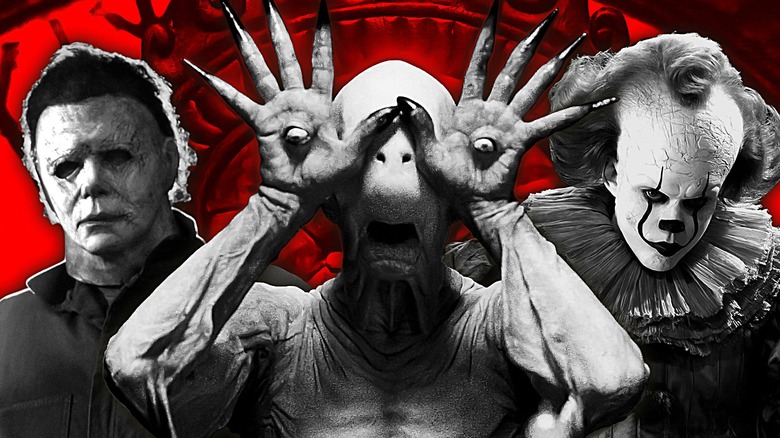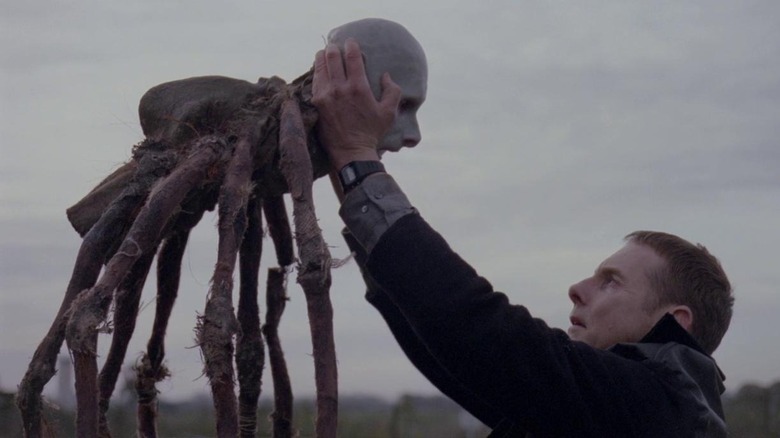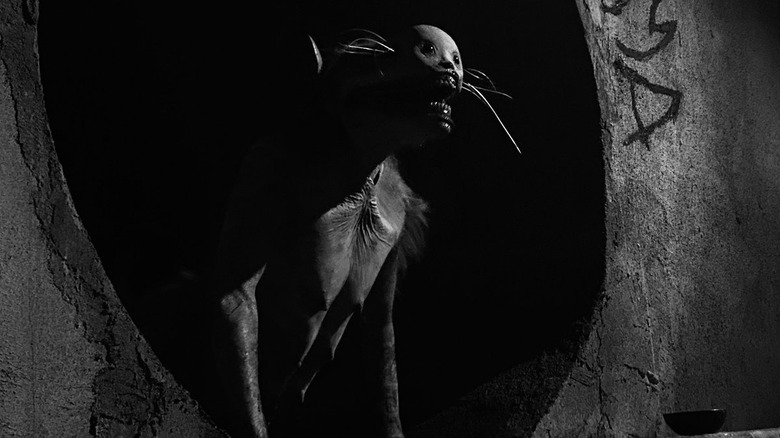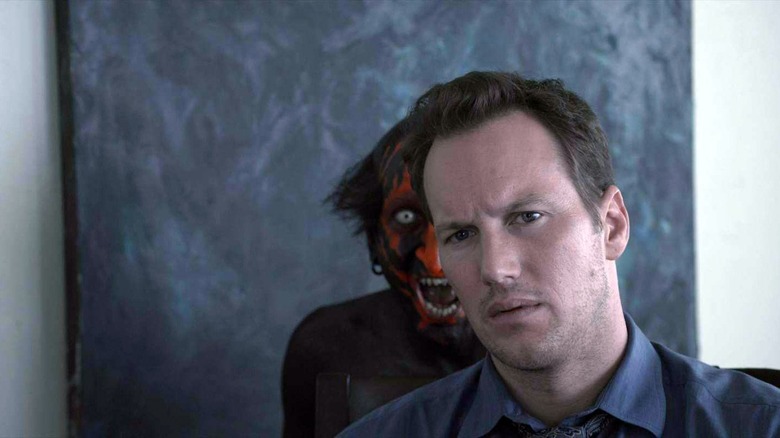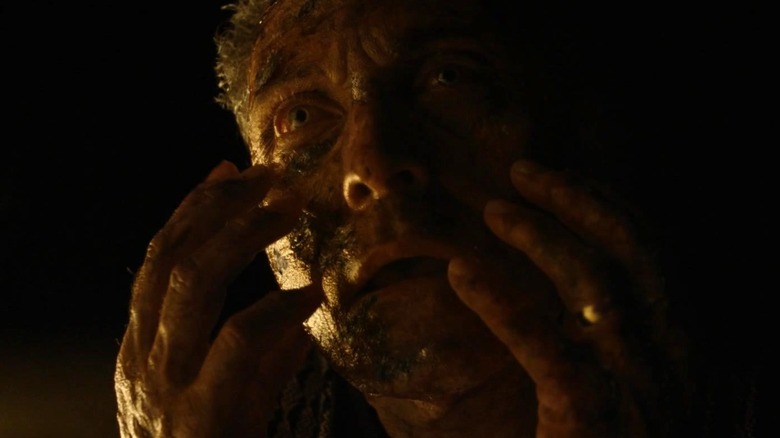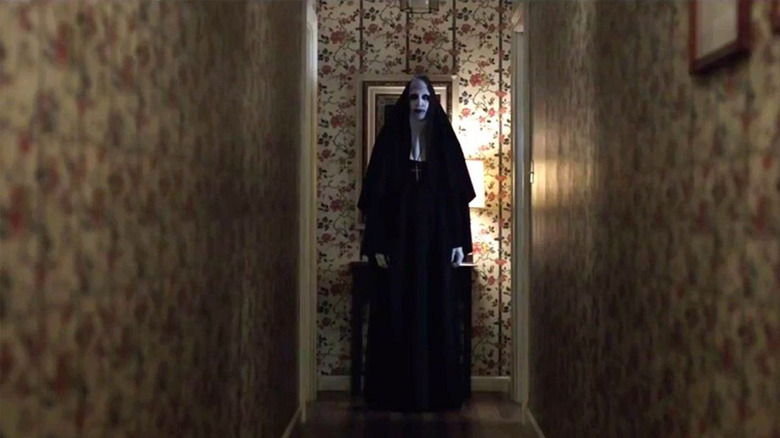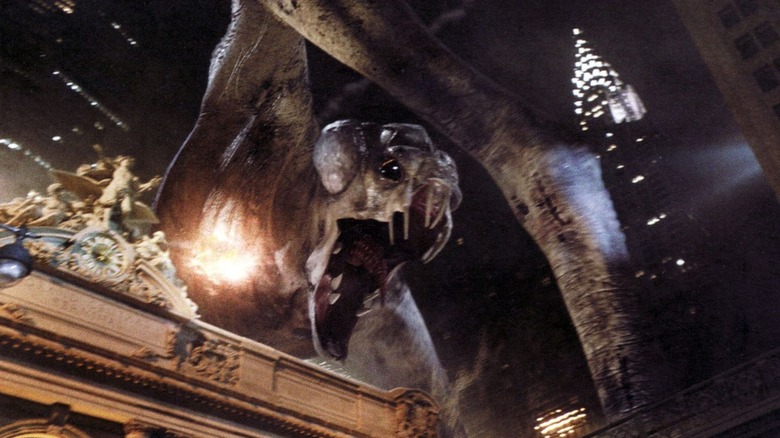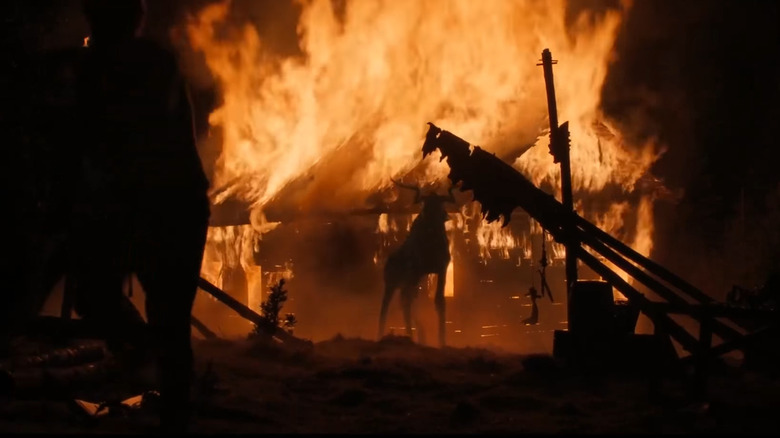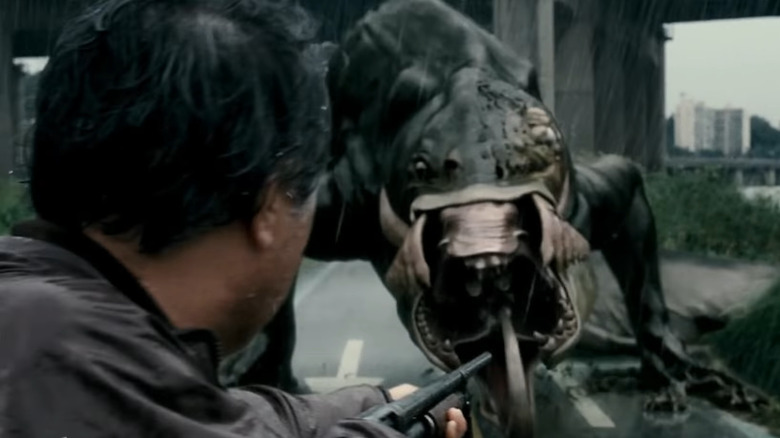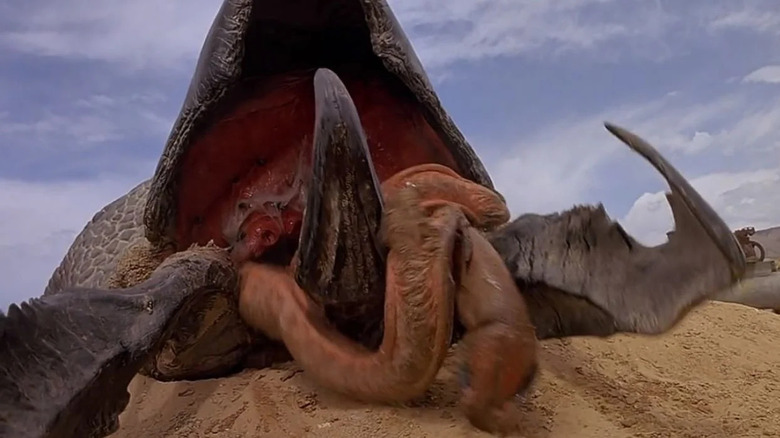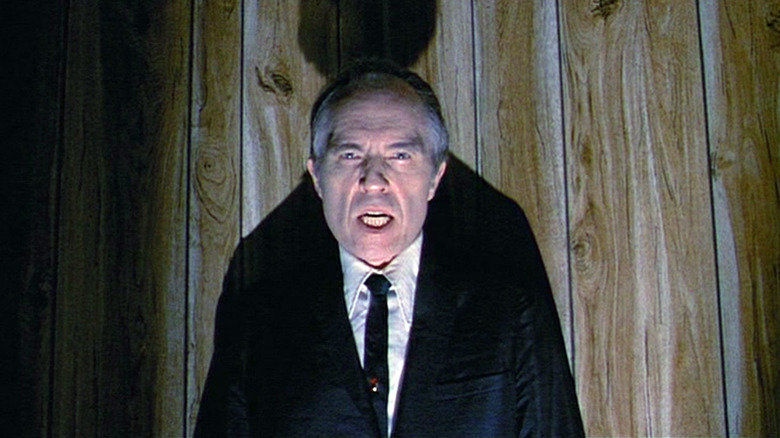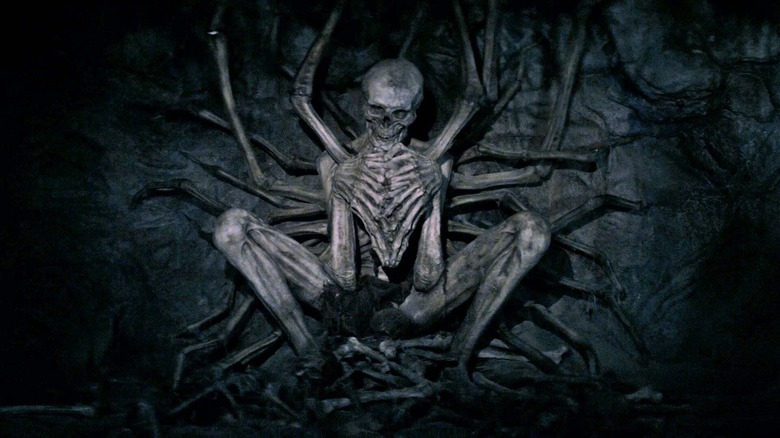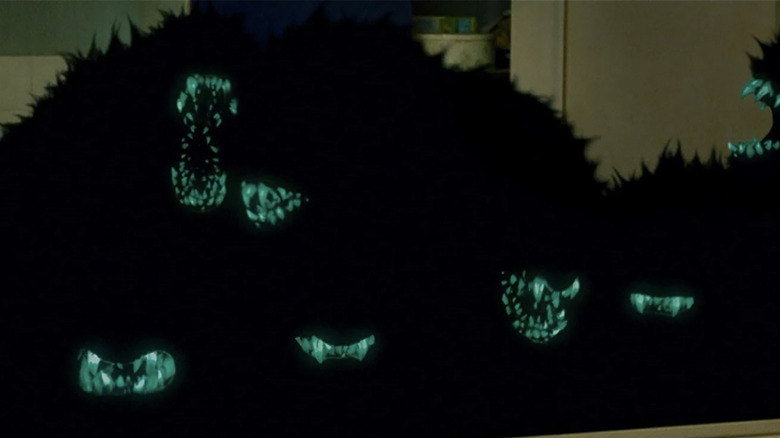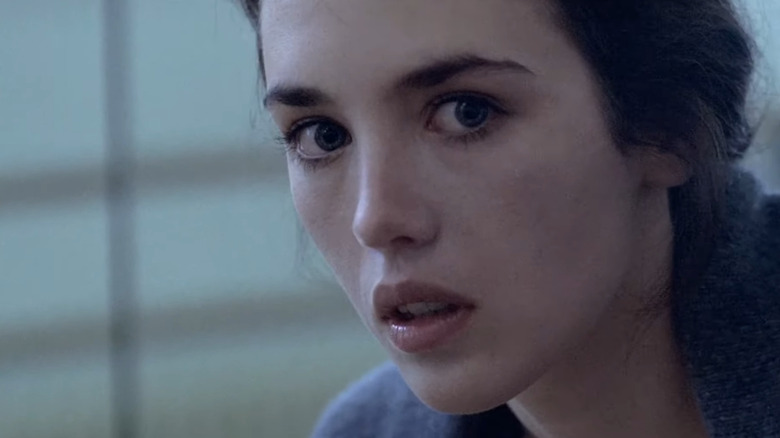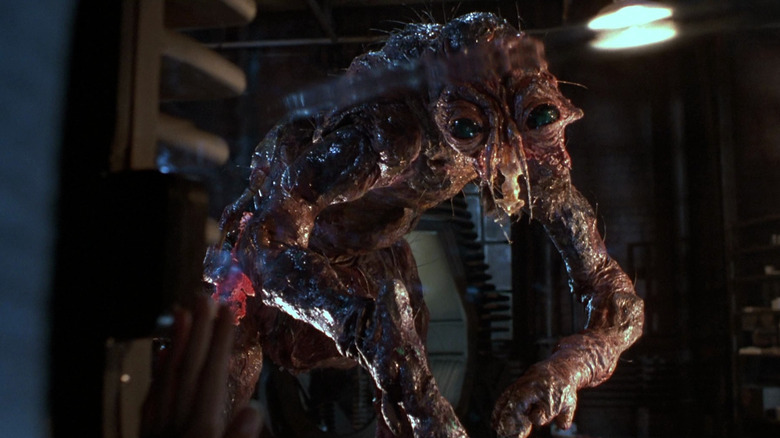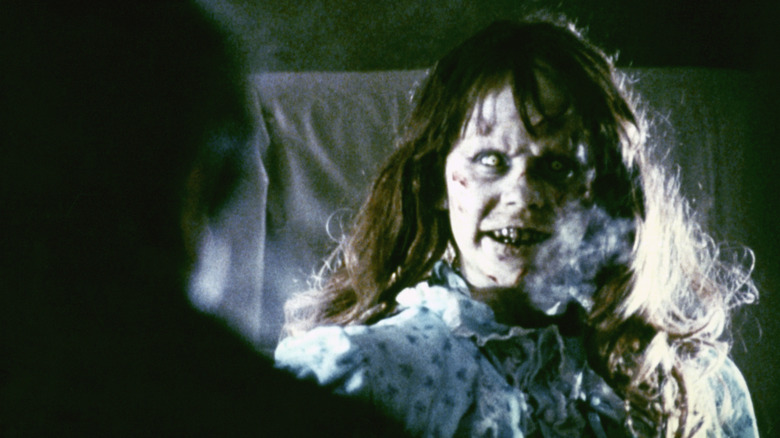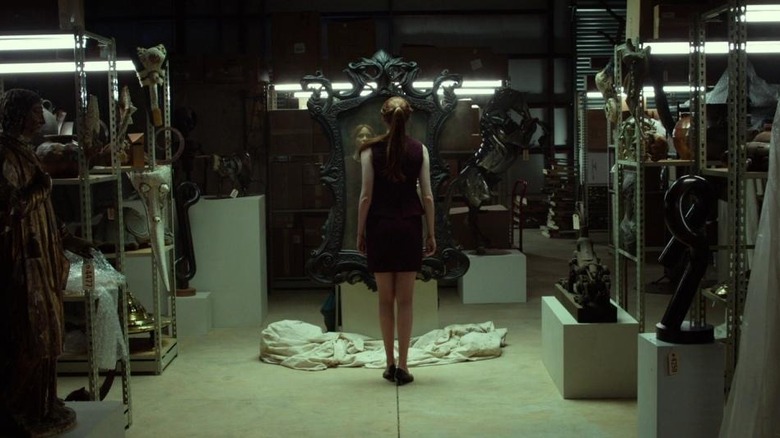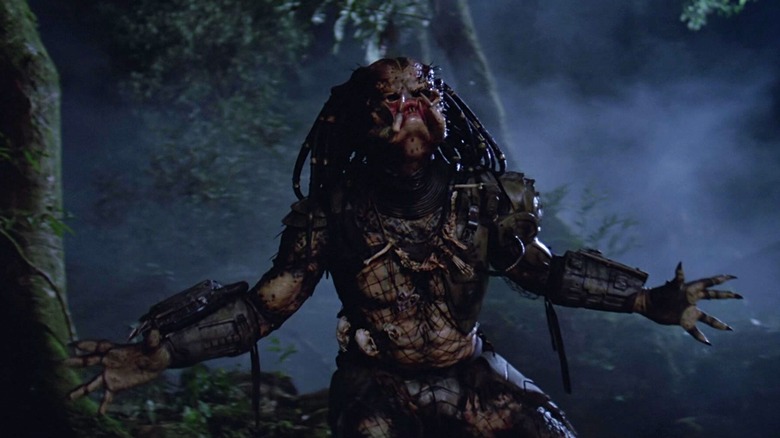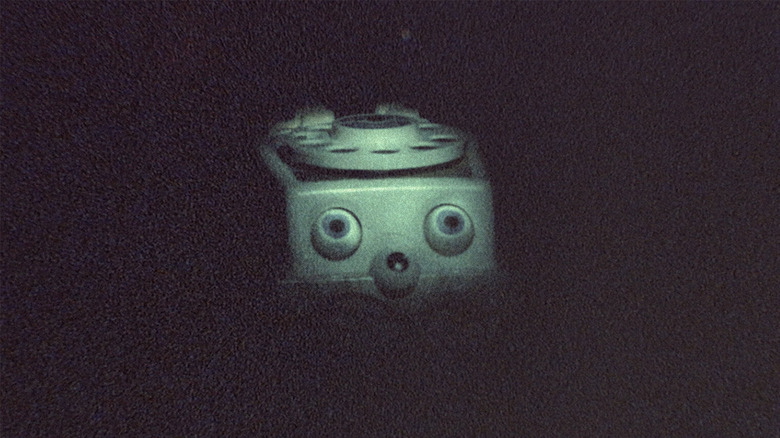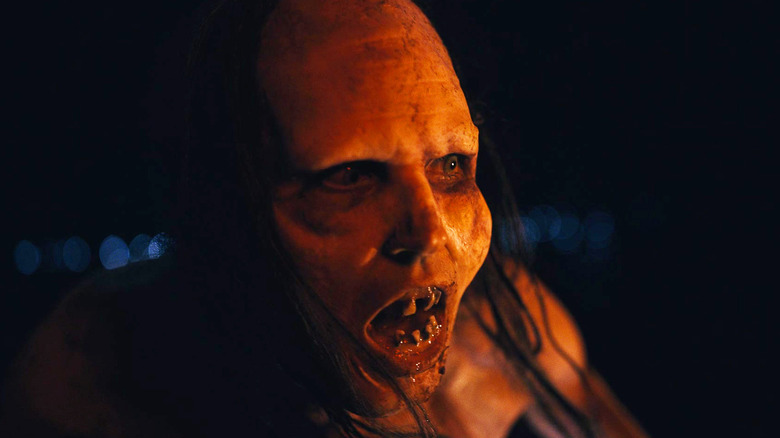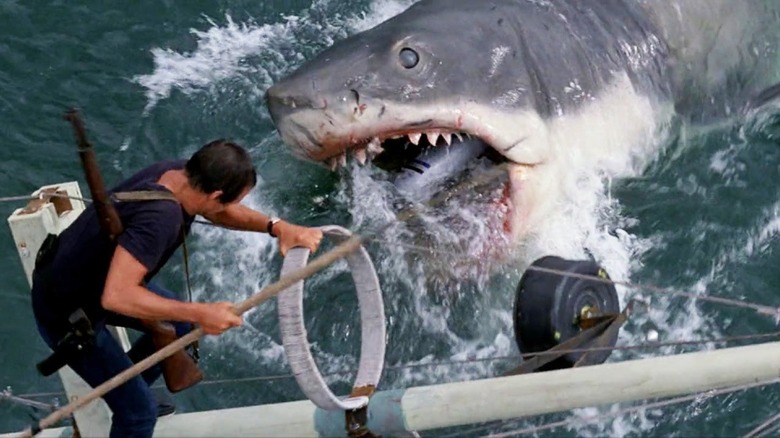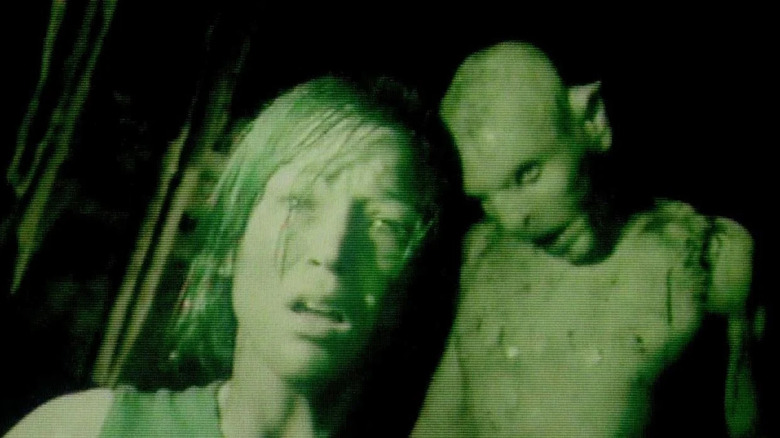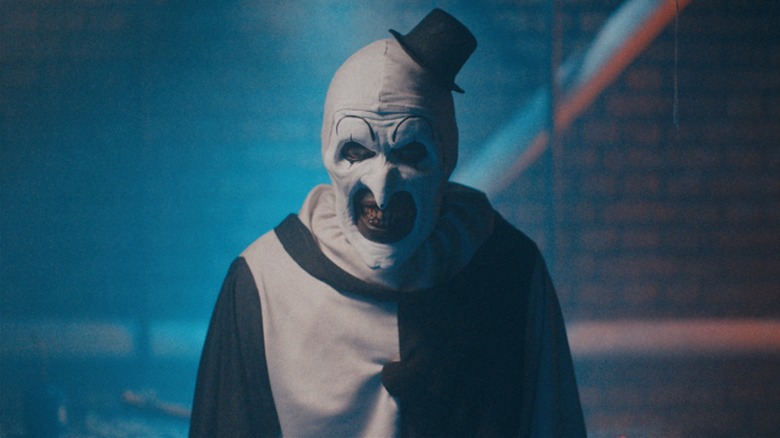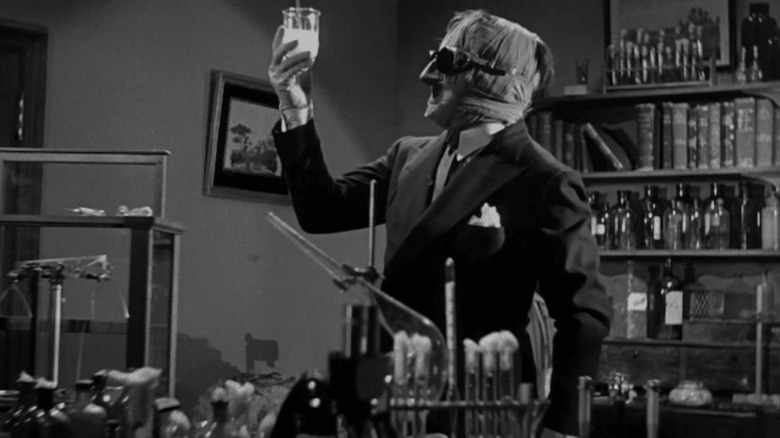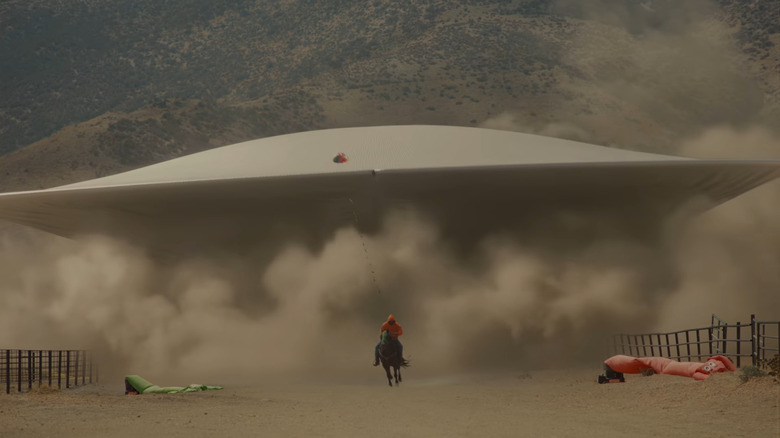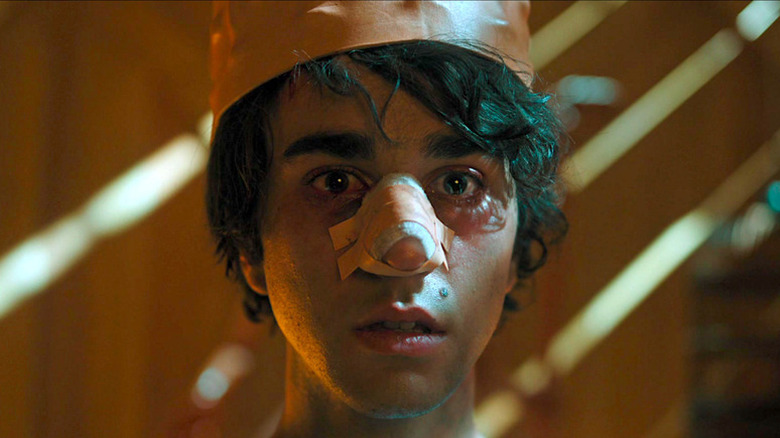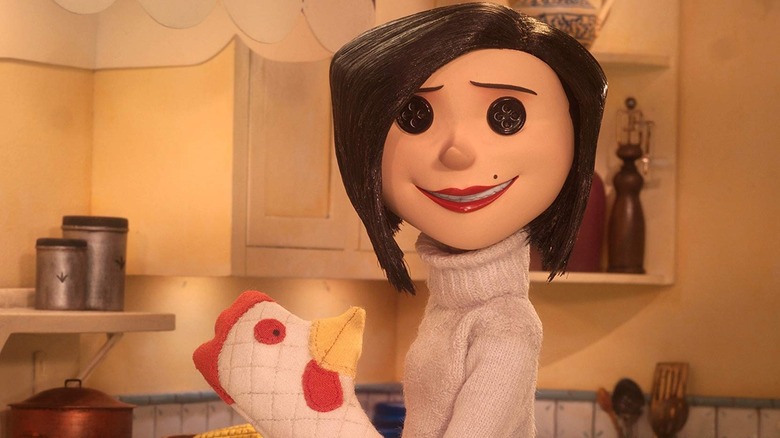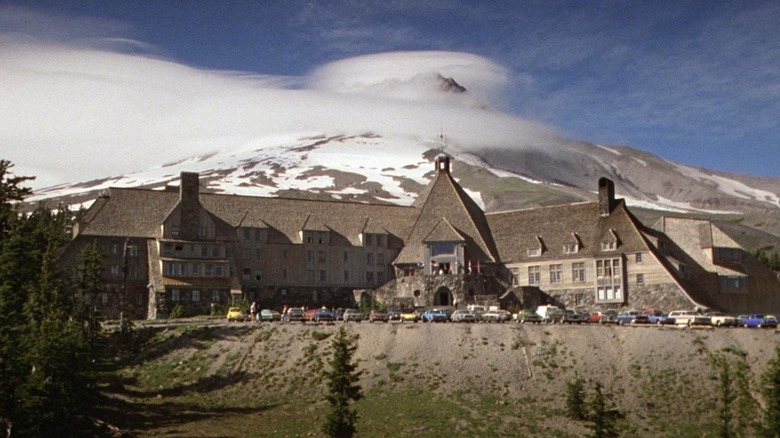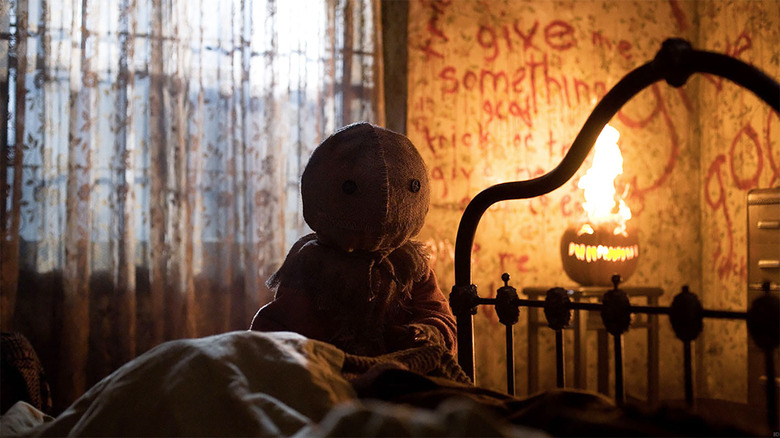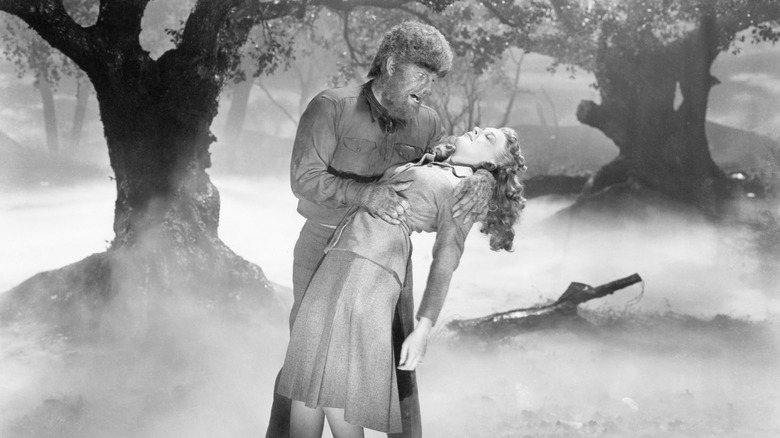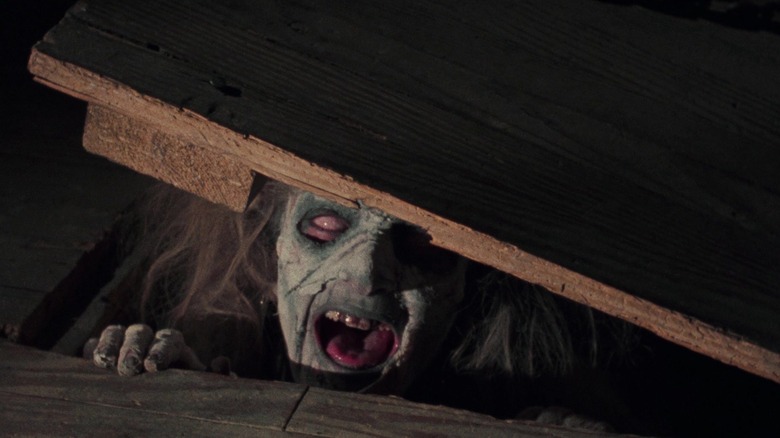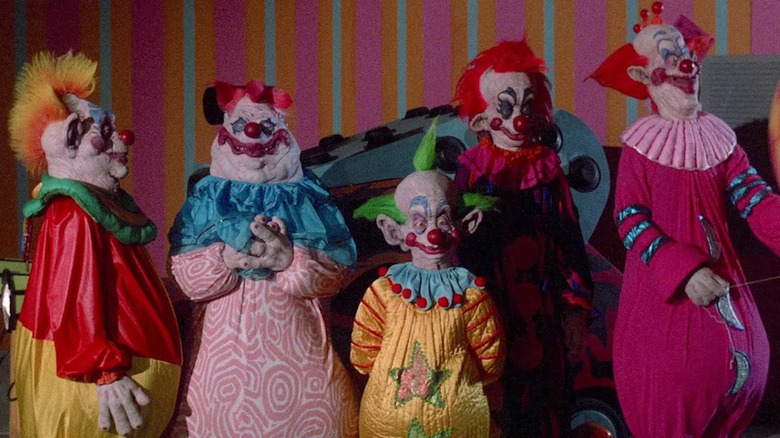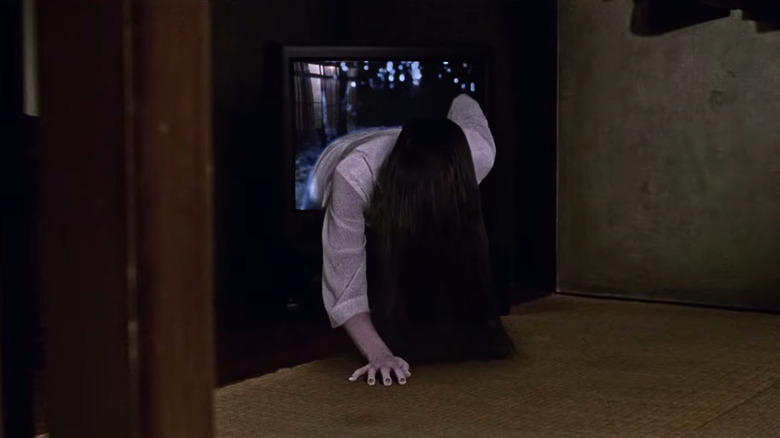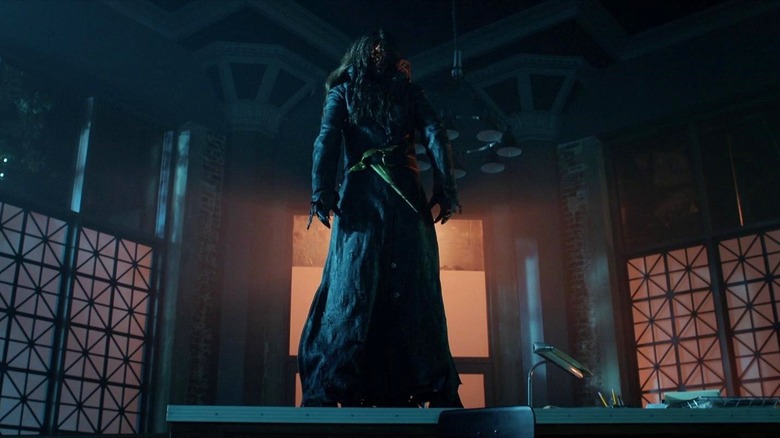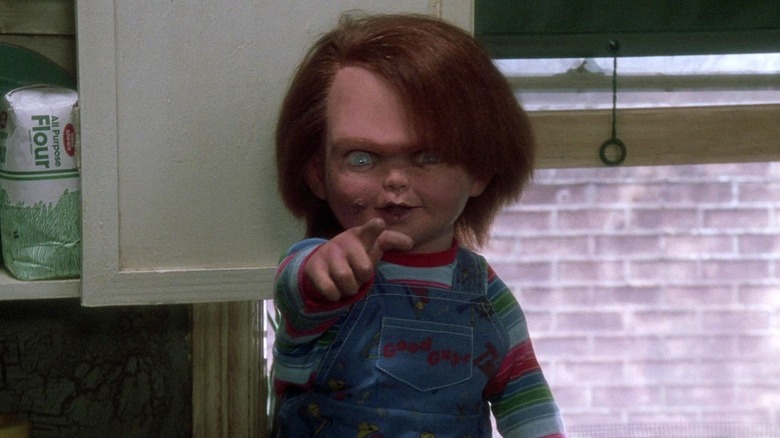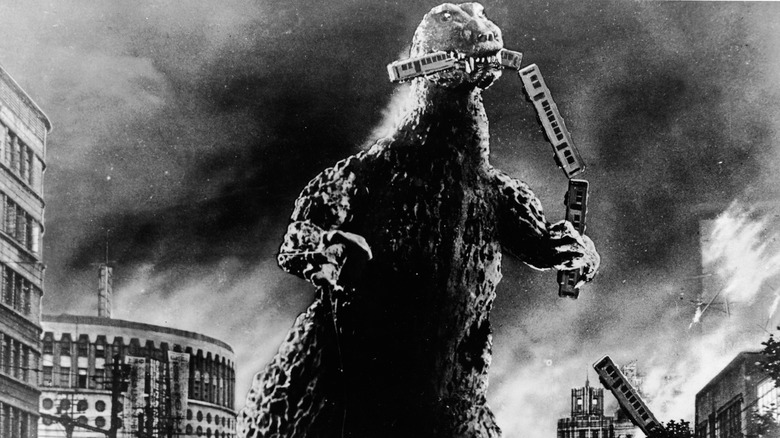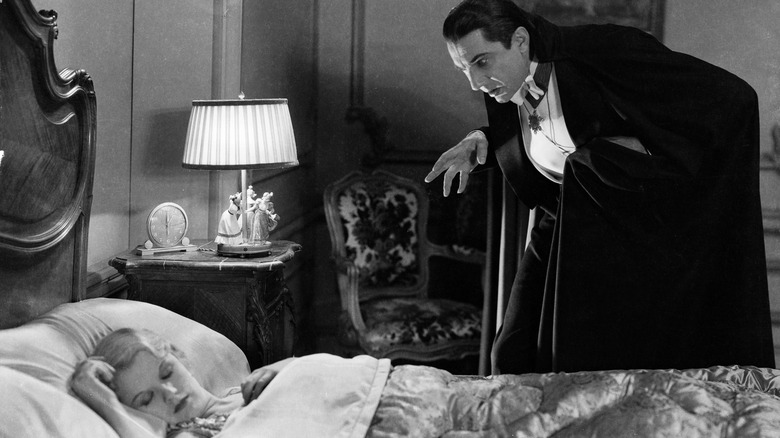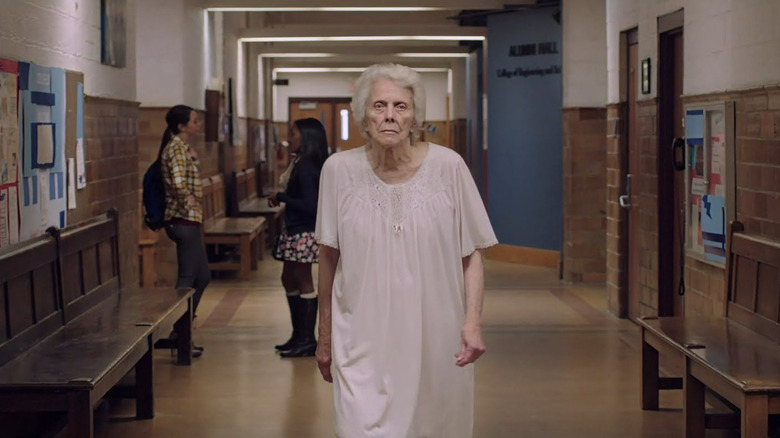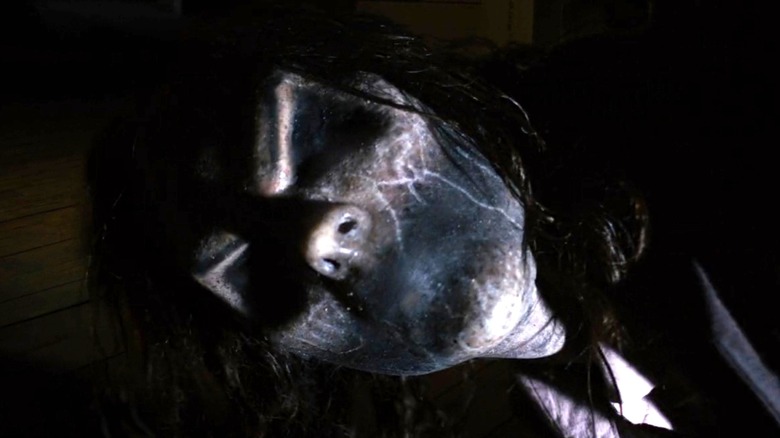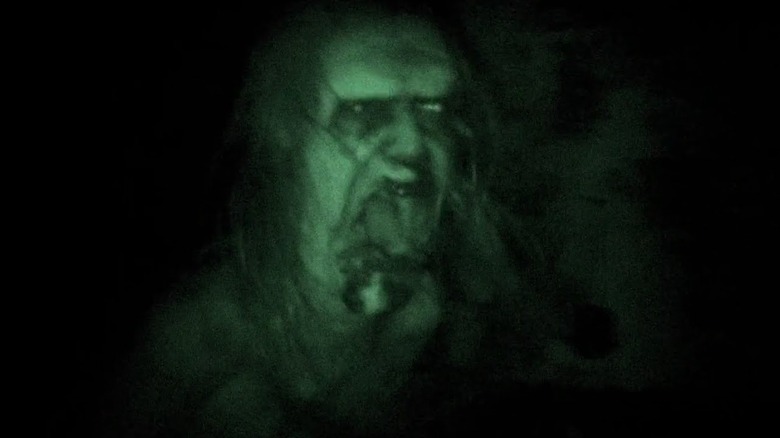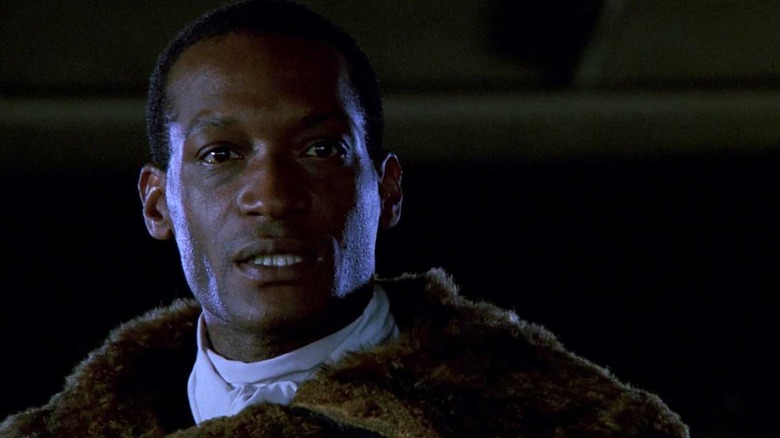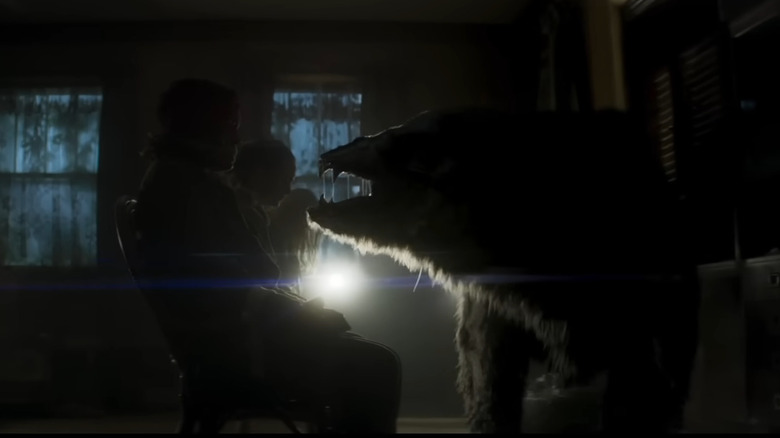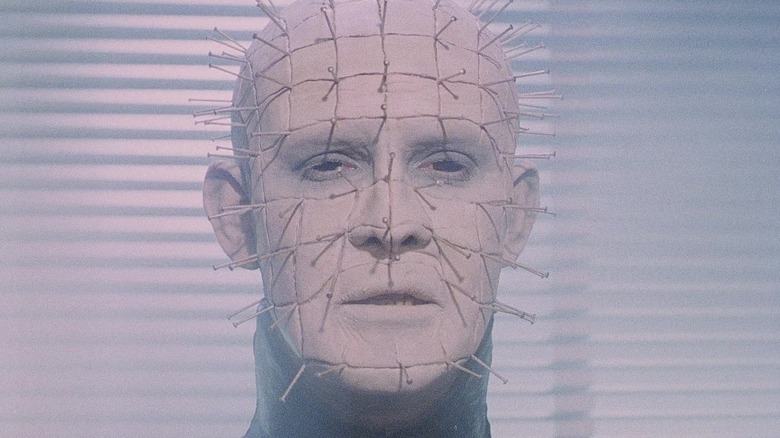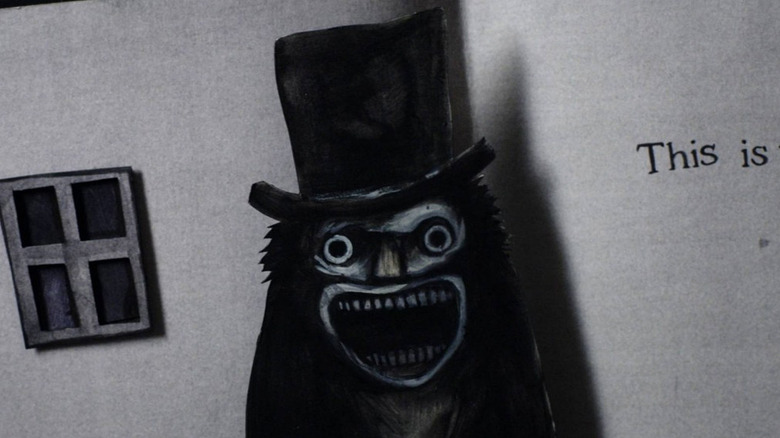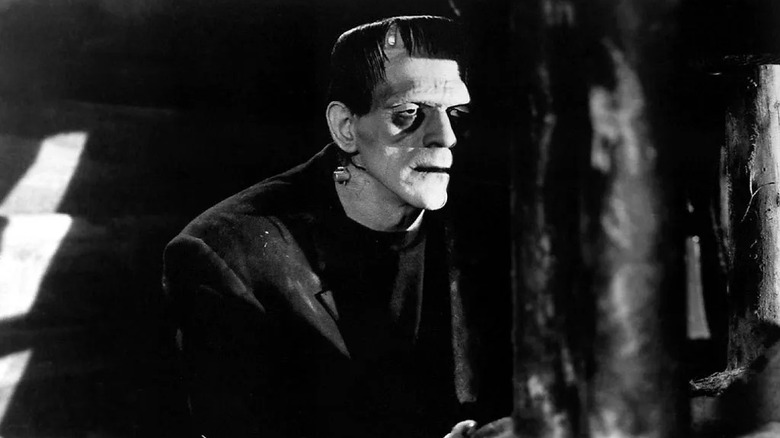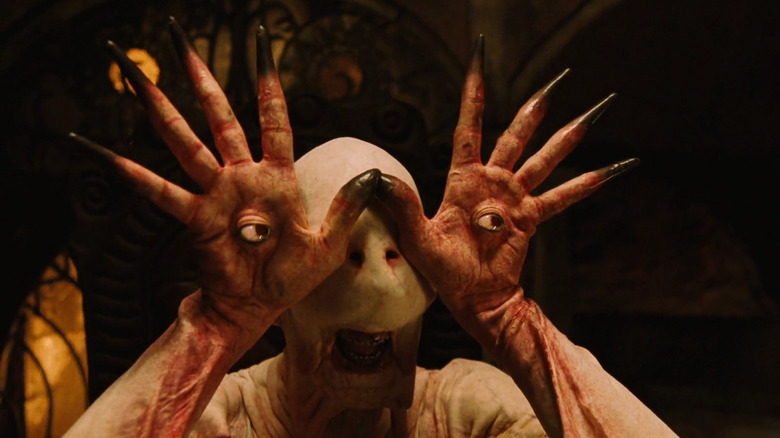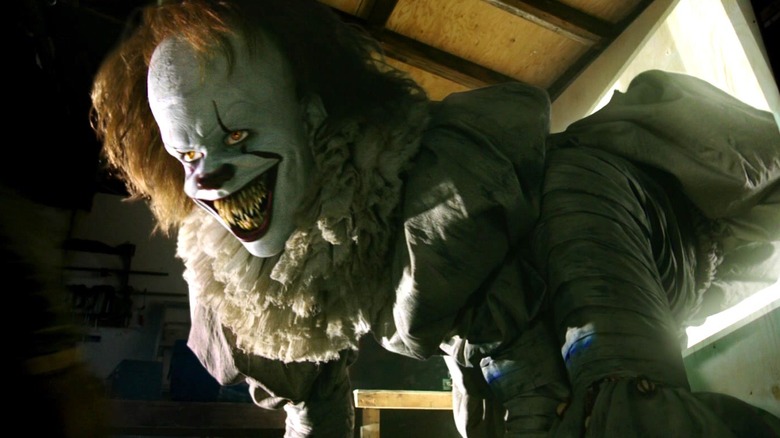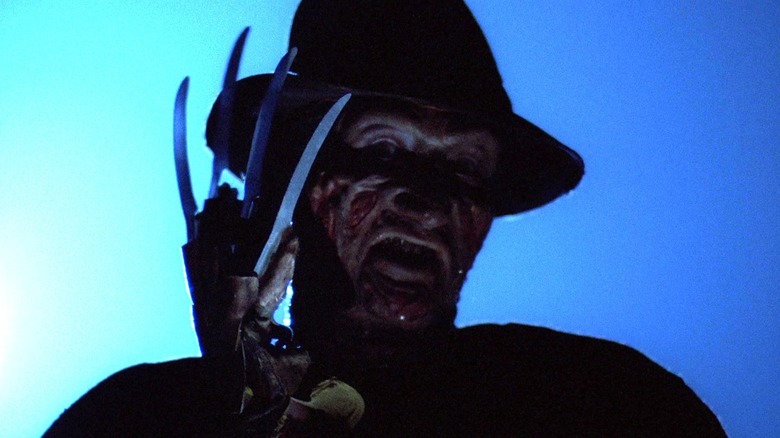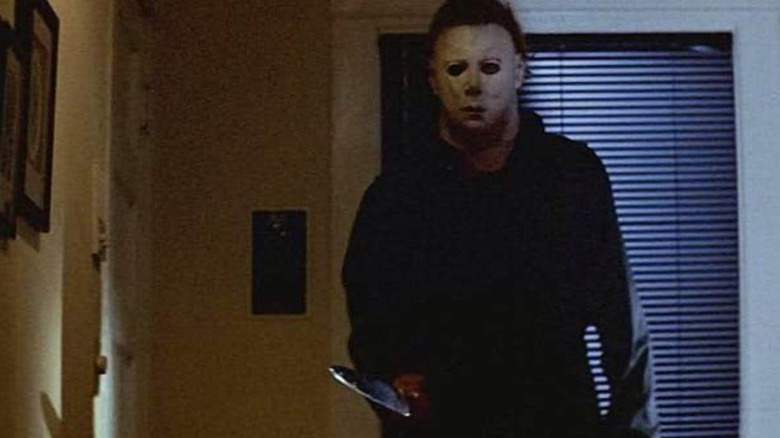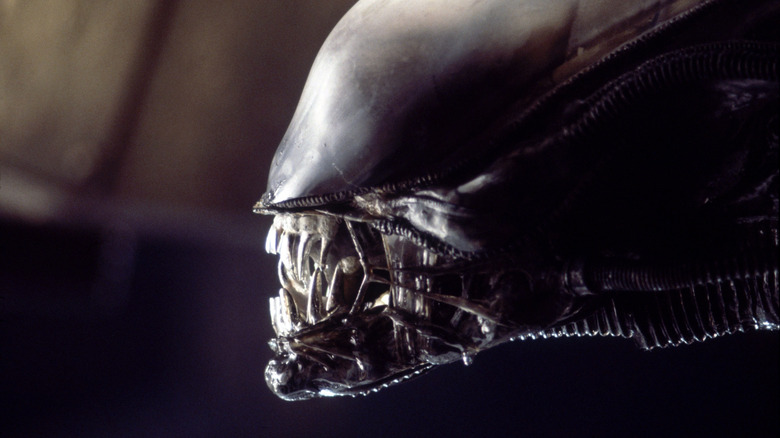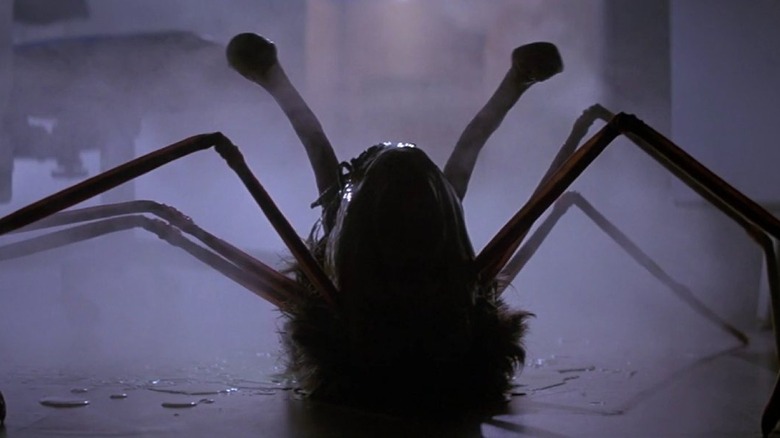The 50 Scariest Horror Movie Monsters Ranked
What scares you? Is it something ephemeral, like the concept of death or failure? Do sharks and slithery things give you nightmares, or is it Freddy Krueger and Michael Myers who keep you up at night? In the realm of terrifying monsters, it's hard to pick the absolute scariest one. Fear is, after all, purely subjective. Many things go bump in the night, but not all of them are created equal. Sure, some monsters will stick with you from childhood until you're old a grey, but others ... well, they lack a certain Je ne sais quois. Not these ones, though. No way.
The /Film horror team put their heads together to come up with an immense list of horror movie monsters that gave them the frights, and while desperately hoping the big shadow that just passed by didn't belong to something supernatural, they whittled that list down to 50 contenders. Here are your scariest horror movie monsters.
50. The Possum marionette – Possum (2018)
"Possum," the depressing, psychological horror film directed by Matthew Holness — who cult horror fans may know as the creator and star of "Garth Marenghi's Darkplace" – tells a story as disturbing as the terrifying puppet monster that gives the film its title.
The story follows a disgraced children's puppeteer named Philip Connell (Sean Harris) who is forced to revisit his childhood home where his feeble uncle now resides. The only bag he brings on his journey is a leather duffel bag that houses a spider-like marionette called Possum that continually haunts Phillip throughout his visit. He tries to discard the puppet, but no matter what he does, Possum seems to make its way back to him. For most of the film, only the puppet's massive spider legs are visible, making the reveal of the spider's human face all the more horrific.
More than just a mere marionette, Possum is the manifestation of Phillip's disturbing past, and its grotesque appearance is a direct reflection of his anguish. (BJ Colangelo)
49. Raatma – V/H/S/94 (2021)
Raatma only has a few seconds of screen time in "V/H/S/94," one of the best entries in the long-running found-footage horror anthology series, but every single one of those seconds leaves an impact. A grotesque rat creature that lives in the sewers beneath a nondescript city and has garnered a following of deranged individuals who worship it as a god, it's a triumph of low-key movie monster design — the fact that you barely see Raatma means it sits in your brain like a shard of glass you can't quite remove. What the absolute heck is this thing?
And unlike so many great movie monsters, Raatma is also darkly funny, with its followers creating some of the biggest laughs and most meme-able moments in recent horror history. Raatma is so nasty, so bleak, that the film's only course of action is transform its influence into the most shocking comedy imaginable. Hail, Raatma! (Jacob Hall)
48. The Man With Fire in His Face – Insidious (2010)
James Wan has created countless monsters throughout his career, but "Insidious" introduced one of his mightiest. The Man With Fire in His Face, aka Lipstick-Face Demon, was an instant frightener when the first "Insidious" trailer played. As the minutes-long teaser plays out, we see glimpses of Lin Shaye as a medium, Rose Byrne as a family protector, and then Patrick Wilson's face — at first. Behind Wilson's father figure seated at the dinner table leers Wan's Darth Maul wannabe, peering into the camera, taunting Wilson from behind. You needn't even see "Insidious" to fear the demon, thanks to possibly the most iconic horror trailer moment of the last decade.
As a resident of The Further, Red-dy Krueger "seeks to bring pain and chaos to the world of the living by possessing a human body." He's distilled hatred with a snarling face, designed like he's the dictionary definition of "Satan's Little Helper." The demon lures Dalton Lambert (Tyler Simpkins) into his lair, chains the boy down, and tortures him to his heart's ill content.
"Insidious" is crammed with tremendous scares, so many due to the demon's daunting stalks as even his blackened figure brings that added spike of anxiety. Once you see the red face, you'll never sleep again. (Matt Donato)
47. The Beach That Makes You Old – Old (2021)
What if the main monster of a horror movie was ... a beach that makes you grow old? A quintessential example of a film that couldn't have been made by any other director or at any other moment in that director's filmography, "Old" — and the killer beach at the center of the story — represents the nexus of all of filmmaker M. Night Shyamalan's famously divisive idiosyncrasies. Even more than terrifying ghosts or megalomaniac supervillains or an invasion of extraterrestrials, the time-defying beach strikes at a very particular yet universal anxiety that Shyamalan exploits to the fullest.
Okay, like much of Shyamalan's work, the real antagonist of "Old" essentially boils down to the disturbing lengths individuals and institutions will go to protect their own self-interests, but the setting of this largely one-location thriller truly manages to crawl underneath the skin. The beach's time-dilation effect is ultimately responsible for a rushed pregnancy gone horrifically wrong, an impromptu and gruesome surgery, and all sorts of traumatic deaths. But, most frightening of all, it forces the characters to grapple with the sick, existential feeling of watching precious moments of life slip away. If that's not a monster, I don't know what is. (Jeremy Mathai)
46. Valak – The Conjuring 2 (2016)
In the intricate lore of James Wan's Conjuring-verse, Valak is the closest thing paranormal investigators Ed and Lorraine Warren have to an overarching Big Bad. The demon gets his time in the spotlight in the "Nun" movies but has also made appearances in three other movies in the franchise to date. First summoned by a Romanian duke, the fallen angel soon gets cozy on Earth and begins possessing nuns at a secluded monastery.
Valak's fear factor depends on what face he's wearing. For example, in "The Nun," the demon masquerades as a nun, showing off his ability to infiltrate the most respected orders of the religion that rebukes him. Valak's nun form is decidedly freaky, but he can be even scarier when he's less obvious.
Despite being able to take over human bodies, Valak seems compelled to taunt his prey. He spells his name in blocks behind Lorraine Warren's head while she sleeps or appears in the back of one of Sister Charlotte's photographs without her noticing. His show of force is sometimes blatant, but other times he can be more sinister and creeping in his methods. No matter what form he takes, he's freaky as monsters get. (Valerie Ettenhofer)
45. Clover – Cloverfield (2008)
American kaiju cinema isn't as popular as it should be, which is a shame because "Cloverfield" is such a phenomenal experiment in perspective and destruction. The title references Project Cloverfield, which the American government uses as a codename for the film's creature. An extraterrestrial beast crashes into the ocean and begins destroying New York City, which we witness through the found-footage perspective of partygoers now fleeing for their life.
There's no defense, and nowhere you can escape given the kaiju's gargantuan size. How is that not pit-of-your-stomach horrific?
Let's cover all the ways Clover — the eventual nickname of the mega beast — can cause harm. Maybe his gigantic stomper crushes you underfoot, or perhaps he chews you in half. Clover could topple a skyscraper or bridge and crush you under debris. The helpless feeling that "Cloverfield" stirs is the ultimate horror vibe, and that's without even acknowledging the violent minions Clover releases from its body that causes victims to explode when bit.
Clover is one of the great American monsters since Y2K, causing a million ways to die that we will never forget. (Matt Donato)
44. Moder – The Ritual (2017)
David Bruckner's "The Ritual" is about a lot of things like toxic masculinity, the pain of growing apart from your friends, and the dangers of camping. But it also happens to feature one of the coolest original creature designs in recent memory.
After a group of friends played by Rafe Spall, Arsher Ali, Sam Troughton, Robert James-Collier, and Paul Reid go on a trek into the woods, they discover an ancient evil, a kind of Norse giant called a Jotunn. One of the friends completes a pagan ritual and manages to summon Moder, a Jotunn whose spirit is tied to that particular forest and happens to be the ill-gotten son of Loki, God of Mischief. That's when things get really interesting.
Moder is a horrifying creation. He's part stag and part human corpse, with a man's torso for a face and arms hanging down below his mouth like a warthog's tusks. He's also huge, towering high into the trees. "The Ritual" is a slow-burning nightmare, but once Moder shows up in his gory glory, it's well worth the wait. (Danielle Ryan)
43. The Gwoemul – The Host (2006)
Though South Korean filmmaker Bong Joon-ho is no stranger to the socially conscious thriller, his 2006 film "The Host" plays with a distinct twist in the sub-genre. After American-sanctioned negligence results in 400 bottles of formaldehyde being poured into Seoul's Han River, all the fish die while something terrifying begins to mutate and take shape. When a string of sightings crop up, all detailing a strange, amphibian creature roaming the riverbanks, a monster finally emerges from the murky depths, wreaking havoc on the city and its populace. In a frenzied panic, snack stall owner Park Gang-du (Song Kang-ho) even loses his young daughter, Hyun-seo (Go Ah-sung), to the monster's slimy clutches.
Dubbed the Gwoemul (Korean for "monster"), the creature resembles a cross of a fish and a salamander, with some horrifying new additions. It boasts a multi-pronged, gaping mouth and a prehensile tail. What makes the creature so eerie, though, is the fact that its backstory has real-world origins. In 2000, the U.S. really did dump all that formaldehyde into the Han River, causing actual mutations in the indigenous fish population. Theoretically, the Gwoemul could emerge from the river's waters at any moment, and America would be totally to blame. (Natalia Keogan)
42. Graboids – Tremors (1990)
Ron Underwood's classic 1990 creature feature, "Tremors," achieves an incredible feat — making 'roided-out earthworms threatening.
Originally theorized as extraterrestrial — "I vote for outer space. No way these are local boys," says Earl Basset (Fred Ward) — the sightless underground monsters, also called the unimaginative "Dirt Monsters," are discovered to be prehistoric rabble-rousers who like to eat livestock, cars, and the occasional bit of human flesh as a treat. Their snake-like appendages are strong enough to hold a running truck back from escape, and they are patient enough to lay siege to their potential lunch for days on end. When they descend upon the high desert, mountain-bound town of Perfection, Nevada, it's an all-you-can-eat buffet. Sensing the vibrations humans make (walking, bouncing on a pogo stick, dribbling a basketball, etc.), it's easy for the creatures — dubbed "graboids" by store owner Walter Chang (Victor Wong) — to spot their next meal.
But there's one thing they don't count on — a pair of aimless handymen, a seismologist, and a Republican prepper couple with way too many firearms. (Anya Stanley)
41. The Tall Man – Phantasm (1979)
Everything about the Tall Man feels ... wrong. Angus Scrimm, with his looming heigh and unusual features, feels less like a human being and more like an alien entity stumbling about in a disguise that never fits quite right. He exudes a cosmic menace, a vibe that could be mistaken for eccentricity by those who aren't paying attention. In other words, he's the perfect fit for "Phantasm" and its sequels, a franchise all about the slow leaking of dream-like chaos into our world. Scrimm, with his bellowing voice and severe face, emerges from the darkness like a nightmare. He's the Terminator — you can't stop him, it's not clear if anything can stop him.
The "Phantasm" series has its ups and downs, but the Tall Man remains a fixed point, an anchor that maintains our horrified fascinations. In a given moment, he looks just like a man. But in action, he's the conductor of universal horrors so extreme that they defy the imagination. His existence is our greatest nightmare. (Jacob Hall)
40. The Empty Man – The Empty Man (2020)
By the end of the outstanding 22-minute prologue of David Prior's slow-burn psychological horror film "The Empty Man," you'll already find yourself questioning what the Empty Man actually is. Is it the bizarre, not-quite-human skeleton found in a shrine in a buried cave in the Bhutan Valley? Is it the strange figure wrapped in rags that stands silently in the snow before charging towards the door of a lonely cabin, only to disappear when the door is closed on it? Is it some kind of demon that possesses one of the unfortunate hikers, causing her to kill two of her friends and then herself?
That's the mystery of the film, and one that protagonist James Lasombra (James Badge Dale) must solve. You won't find much in the way of jump scares in "The Empty Man," and there's only minimal gore. Mostly, the Empty Man manifests as a steadily rising dread, and the payoff when his true nature is revealed cuts deeper than any knife. (Hannah Shaw-Williams)
39. The Wolf Aliens – Attack the Block (2011)
Darkness is always scary. So when a monster can blend seamlessly into the dark without alerting you to its presence until it's too late, there are few things more terrifying. That's what makes the wolf aliens in "Attack the Block" such great monsters. The pitch-black hair that covers their entire body makes it supremely difficult to see them in the dead of night on the streets of South London. It's only when they open their mouths that they're revealed, and that only makes them more scary. Without any eyes (at least that we can see), you can only notice these creatures in the dark due to the electric blue glow of their deadly, sharp teeth, so there's not even a bloodthirsty glare to stare into before their attack.
Making the wolf aliens even more menacing is the fact that they're driven by their instinctual nature. Why are they attacking these teens on their home turf? Because the guys had a run-in with a female alien, and they've been carrying around its body all over the block with them. All the male aliens (maliens?) can smell their potential mate, and they keep chasing its pheromones. The wolf aliens would literally kill a bunch of kids rather than not get laid. (Ethan Anderton)
38. The Tentacle Monster – Possession (1981)
Andrzej Żuławski's psychological horror drama "Possession" is a film that feels as if it defies description. Better suited as an experience rather than something to watch, "Possession" tells the story of Sam Neill's Mark, a spy who upon realizing his wife, Anna (Isabelle Adjani) is seeking a divorce, is thrown into a world of nightmarish psychosis as he slowly uncovers the truth of his wife's infidelity.
The film was banned in many places upon its release in 1981, due in large part to the way horror and sexuality are visually intertwined throughout. "Possession" is a film as horny as it is horrific, with Adjani's Anna seeking the pleasure not of a random lover but of a gooey, gruesome, tentacled monster. The creature is given minimal screen time, but the image of it writhing on top of her is enough to sear itself into the subconscious of anyone watching. The monster's impact on both Anna and Mark inspired two of the most grueling performances in horror history.
Life gets pretty weird after you do the dirty deed with a gigantic tentacle beast. (BJ Colangelo)
37. Brundlefly – The Fly (1986)
Remaking a classic horror movie is one of the biggest risks a director can take, but for David Cronenberg, "The Fly" helped solidify his reputation as one of horror's greatest masters.
"The Fly," a remake of the beloved B-movie of the same name, showcases the revolting demise of Jeff Goldblum's Dr. Seth Brundle, a brilliant scientist who believes he has discovered the key to teleportation. In what would become quite possibly the biggest drunken mistake ever put to film, Dr. Brundle attempts to test his telepods on himself, unknowingly merging himself with a housefly in the process. The results are grotesque, as Dr. Brundle slowly transforms into the monstrous creature known by horror fans as Brundlefly. His body mutates and falls apart, growing increasingly more repulsive by the hour.
Thanks to the Academy Award-winning practical makeup work of Chris Walas and Stephan Dupuis, the unsightly vision of Jeff Goldblum's metamorphosis has been effectively terrifying (and grossing out) audiences for nearly four decades. (BJ Colangelo)
36. Regan MacNeil – The Exorcist (1973)
Often dubbed one of the scariest movies of all time, "The Exorcist" caused fainting spells, walk-outs, and shudders of disgust when it premiered theatrically in 1973. Archival footage of audience reactions at the time shows that people were far more scared of Regan MacNeil (Linda Blair) than her possessor, Pazuzu. "She turned her head around," one young woman stuttered in horror after leaving the screening, immediately hiding her face in her date's jacket. Even the mere mention of the scene was too horrifying to handle.
It makes perfect sense why a 12-year-old girl, covered in neon-green vomit and with blood oozing from every orifice, continues to inspire nightmares as opposed to the stony-faced Pazuzu. Something seemingly harmless and gentle is transformed into an inhuman threat, her demonic voice change and physical contortions an affront to human nature itself. She is at once innocent and corrupted, and there's no concrete explanation as to why she was marked for possession. This is what's truly so terrifying about Regan: If the Devil chose her to be his vessel, what's to say he can't claim you?
Forget Catholic guilt — "The Exorcist" is the ultimate example of Catholic anxiety. (Natalia Keogan)
35. The Lasser Glass – Oculus (2013)
Most of the monsters on this list are alive in some quantifiable way, but the villain at the heart of "Oculus" wears the mask of an inanimate object. The Lasser Glass — a mirror that's killed 45 people and counting — is one sick puppy, capable of manipulating reality for anyone who comes near it. In Mike Flanagan's pulse-pounding film, it faces off against Kaylie (Karen Gillan) and Tim (Brenton Thwaites), two traumatized siblings whose family was ripped apart by the mirror years ago.
While most cursed objects are revealed to be associated with some outside participant or demonic presence, in "Oculus," the Lasser Glass is the presence. The antique has been taking lives since at least 1754, including killing the pair's parents. It can bend perceptions in a deeply creepy and tragic way, relentlessly messing with time, space, and its victims' heads. It can also, memorably, make a person take a bite out of a light bulb.
The heroes of "Oculus" are extra-clever horror movie protagonists, making their continued inability to overcome the mirror's dark enchantments all the more terrifying. (Valerie Ettenhofer)
34. The Predator – Predator (1987)
The Predator has been through quite a few iterations over the years. Some of them are scarier than others, but none of them hold a candle to the original from 1987's "Predator." Arnold Schwarzenegger stars in the film directed by John McTiernan about a group of special forces commandos who go into the Central American rainforest to rescue hostages from guerrilla forces. Unfortunately, they also encounter the Predator, an alien warrior who travels from planet to planet, hunting the universe's most dangerous prey.
The original Predator was played by Kevin Peter Hall in a monster suit. Initially, the Predator appears to have a smooth, metallic face, but this is revealed to be a helmet. He's actually got some mega mandibles and a whole lot of razor-sharp teeth under there. He's terrifying because he's the galaxy's greatest hunter, with cloaking capabilities and lots of practical battle skills. He can be pretty cool when he's on your side, like in the "Aliens vs. Predator" series, but it's never good to be his prey. (Danielle Ryan)
33. The Entity – Skinamarink (2023)
The Entity from "Skinamarink," not pictured, never actually appears on screen. Or maybe it does, and it is pictured. Or maybe it doesn't exist. Maybe it's all of those! Like all the horrifying monsters on this list, it doesn't actually matter if it's real. If it terrifies the stuffing out of us, it's "real" enough.
"Skinamarink" takes place inside a typical suburban home, where two young children wake up in the middle of the night and discover their father is gone, the television is on, the lights are off, and the windows have disappeared. So have the doors that lead outside. Their house is now a purgatorial void. All they know is they have toys and distractions, and occasionally a voice tells them to do things, like go upstairs and see something terrifying or harm themselves.
It has been argued that "Skinamarink," which takes place entirely in a liminal space our subconscious wants to fill, might only be a dream or a metaphor. But real or not, the entity that abducts these children, steals their mouths, and leads them to a shocking end is a nightmare that we can't get out of our own heads, where it is likely to live forever. (William Bibbiani)
32. The Mother – Barbarian (2022)
A truly ghastly abomination inspired by a classic literary monster, what makes the Mother from 2022's "Barbarian" deserving of her spot on this list is not that she's the deformed product of prolonged i********* abuse — though that should be disturbing enough to earn her a nod. What makes The Mother so scary is that even after she's revealed in all her twisted glory, she remains just as terrifying as when we didn't know exactly what kind of wretched beast stalked the basement of that cursed Airbnb.
Using the audience's imagination against them is one of the most powerful tools in any horror director's arsenal. "Barbarian" uses that trick for its first act, where we know there's some nebulous evil afoot, but we don't know exactly what form it's going to take. But even after the full reveal of the Mother and her appalling origins, she somehow remains just as terrifying, managing to live up to our worst fears of what malevolence awaited us. That surely makes her one of the great movie monsters. Director Zach Cregger even manages to make us feel sorry for the poor beast by the end, which only serves to make the things even more upsetting. (Joe Roberts)
31. Bruce – Jaws (1975)
Steven Spielberg delivered perhaps one of the most universal terrors in cinema history in 1975 with "Jaws." Not only did he essentially create the summer blockbuster as we know it, but "Jaws" introduced us to one of the most terrifying monsters to ever grace the silver screen. So what made the shark affectionately known as Bruce so terrifying? This was a little too close to reality to be comfortable.
It all starts with that famous tagline, "You'll never go in the water again." Virtually anyone who has ever seen "Jaws" has likely experienced a moment of hesitation before setting foot in a big body of water. What lies just below the surface? Is there some beast full of razor-sharp teeth looking for an easy meal? It's a combination of the very real, as sharks have been around for millions of years, and the unknown that lies just out of sight that makes Bruce so viscerally terrifying. It certainly doesn't hurt that the shark itself is monstrous, not to mention the impact of John Williams' iconic theme, but the fact that so much of the horror and death is about what we aren't seeing is what makes it so horrifying.
Sometimes our imaginations can fill in those gaps better than anything tangible ever could. (Ryan Scott)
30. Crawlers – The Descent (2005)
"The Descent" is one of the 2000s greatest horror triumphs. Y'all wanna explore caves with claustrophobic passageways? Be my guest. Shimmy your way around stalagmites and venture into pitch-black unknowns at your own peril because you might find imp-like, feral beasts that toss bones picked clean of flesh into a bloody pool.
Neil Marshall's Crawlers are a species of humanoids who've evolved underground, physically adapting to the landscape of subterranean cave systems. Their ears are pointed, noses rigid and flat against faces like a bat, exhibiting nocturnal traits on top of their predatory instincts. Crawlers scale walls, hunt using echolocation, and don't need flares to see. The way Crawlers scamper, gliding across slippery rock faces that would cause veteran spelunkers to pause, is enough to make you stay away from any cave entrances.
Sarah (Shauna Macdonald), Juno (Natalie Mendoza), and their friends are no match for the creatures that view the humans as invaders, as Crawlers chew, chase, and massacre them with ease. (Matt Donato)
29. Art the Clown – Terrifier (2016)
In the sea of scary killer clowns, there's one that dons a monochrome onesie and a creepy grimace while on the hunt for victims. He doesn't speak a word — he mimes, swinging to unpredictable extremes while toying with his targets, the silence intensifying the brutality with which he tortures and mutilates. This demented killer, Art the Clown, first debuted in a short titled "The 9th Circle," and after appearances in several horror anthologies, he is now the beating heart of the "Terrifier" franchise. While Art's mere presence onscreen is enough to induce genuine fear, his murder rampage in "Terrifier" cements him as a new, yet formidable movie monster with an edge.
The most terrifying aspect of Art's personality is the lack of motivation behind his brutal killings — his targets are random, and his methods for torture are as whimsical as his mimes. We know next to nothing about his origins and the true nature of his abilities, which are undoubtedly supernatural, despite the grounded, albeit theatrical nature of the kills. There are no shades of grey when it comes to Art, as the killer clown is solely driven by the sadistic urge to indulge in vile acts and brutal extremes. (Debopriyaa Dutta)
28. The Invisible Man – The Invisible Man (1933)
There's an old adage in horror that the scariest things are those that remain unseen. No movie monster embodies that like Griffin, the Invisible Man, whose body bends light to keep others from seeing him. This futuristic movie monster debuted on the pages of H.G. Wells' eponymous 1897 novel.
"The Invisible Man" was one of science fiction's early love affairs with horror and that torrid romance carried on when director James Whale adapted the book in 1933. Whale's film created a look for the character, worn by actor Claude Rains. Griffin's face was bandaged like a burn victim with glasses standing in for eyes; he could only manage to appear with the outline of a human form. It leads to a visual trick when the wrap comes off, and there's nothing there, Griffin's spine-tingling laugh emerging from no visible mouth.
The 2020 remake directed by Leigh Whannell plays the Invisible Man (Oliver Jackson-Cohen) for pure horror, taking advantage of CGI to show the kinds of murders an unseen force could pull off (hint — one involves a floating knife). Rains' Griffin, though, has a melancholy to him. There are few things sadder than feeling invisible. (Devin Meenan)
27. Jean Jacket – Nope (2022)
Jordan Peele takes our love of spectacle into an absolute nightmare in "Nope," exploring the price of art and entertainment and the lengths we go to try and control nature for the sake of "the perfect shot" through the lens of a creature feature. Initially presented as a UFO, Peele frames the alien entity referred to as Jean Jacket like the shark from "Jaws," mostly hidden among the clouds. Though we don't get a good look at it for most of the film, we never stop feeling the presence of Jean Jacket, nor seeing the consequences of its actions.
The scariest scene in the movie shows a cowboy show that goes horribly wrong, with shots of people covered in viscera and being slowly digested inside the creature. Plus, the alien changes and transforms throughout the film, like an Angel from "Neon Genesis Evangelion," adding to its mystery and also to its horror, as we never even begin to comprehend what it is or how it works. Though new to the scene, Jean Jacket made one memorable impression that will stick with us for years to come. (Rafael Motamayor)
26. King Paimon – Hereditary (2018)
One of the scariest monsters in 21st-century horror never shows its true face. Still, the spirit of King Paimon lingers in the dark and quiet terror of every moment of "Hereditary." Ari Aster's feature debut coats the air with a choking sense of wrongness from early on in the movie and lets the dread of Paimon's unseen force escalate into a wild and horrific climax. Audiences will have forgotten to breathe by the time Alex Wolff's Peter flings himself through a window and shuffles, possessed, into his treehouse shrine.
"Hereditary" makes Paimon terrifying by refusing to explain him, instead offering clues and details leading up to the final, gruesome revelation that the family's tragedies have all been in honor of the dark deity. Viewers don't know exactly what he wants or why, but it's clear that he gets it by causing deep hurt and tremendous fear. The fact that his manipulations feed on situations that can happen to anyone, like mental illness, accidents, aging, and death, makes Paimon's power all the more frightening. (Valerie Ettenhofer)
25. The Beldam/Other Mother – Coraline (2009)
Coraline Jones' mom is a total buzzkill. She almost never lets Coraline do what she wants and is too busy doing boring adult things with her husband to give Coraline the attention she craves. So, when Coraline ventures to the Other World and meets her Other Mother, she's immediately enthralled. Other Mother makes her delicious foods and encourages her to check out the wonders of the Other World, which is just like Coraline's home but more colorful and way more fun. One day, her Other Mother tells Coraline she can stay there forever if she wants.
All she has to do is sew a pair of buttons over her eyes, like everyone else in Other World.
"Coraline" is a story about how growing up isn't as scary as it seems, but it's also a story about how being trapped as a child forever would actually be horrifying. The Other Mother, aka the Beldam, and her request perfectly embodies that horror. As unnerving as the Beldam is when she eventually reveals her true form (with her spidery build, cracked face, and clawed fingers), it's the smiling, relentlessly perky facade she adapts to deceive Coraline that's truly unsettling. (Sandy Schaefer)
24. The Overlook Hotel – The Shining (1980)
Stephen King is known for a prolific career full of terrifying monsters. One of his most iconic and terrifying creations was the Overlook Hotel. The Overlook first graced the pages of King's 1977 novel "The Shining" before its 1980 feature film debut. When troubled writer Jack Torrance moves his family into the Overlook as its winter caretaker, he soon discovers that the hotel is full of predatory spirits of deceased guests. What's worse, it wants to corrupt Jack in an effort to take his son Danny because of his nascent psychic abilities.
The Overlook isn't merely a haunted hotel — it's a sentient being with malicious desires and intent. It also happens to be able to twist its guests and ensnare them forever. What really drives the terror home is the fact that its horrors are completely personal, using Jack's alcoholism and isolationist tendencies to turn him against his own family. It's a sentient, corrupting hotel that knows its victims and weaponizes their deepest weaknesses against their loved ones in a cycle of blood and death. Few things are scarier. (Jeff Ewing)
23. Sam – Trick 'r Treat (2007)
With orange footie pajamas, a smiling, stitched burlap scarecrow face with button eyes, and a little sack in his hands, Sam might seem like a cute trick or treater. But the longer you stare at him, the scarier he becomes, especially when you notice that sharp pumpkin lollipop he's carrying around. For most of "Trick 'r Treat," Sam is merely an observer of the gnarly events unfolding on Halloween, but his presence becomes more and more ominous as the series of tragic stories continues. It's not until Sam gets his own segment that his horrifying nature becomes clear.
Underneath Sam's burlap head-covering is a nasty mix of a skull and a jack-o'-lantern, his flesh looking like the interior of a pumpkin, his teeth sharp and crooked. Not even the blast of a shotgun can take him down. Sam can reanimate and continues on his mission, which seems to be enforcing the rules of Halloween. In this case, Sam just wants to make sure that the old curmudgeonly Kreeg (Brian Cox) is handing out candy to the neighborhood kids, so he punishes him with a candy bar hiding a concealed razor blade before going on his way and letting Kreeg live. Trick or treat, indeed! (Ethan Anderton)
22. The Wolf Man – The Wolf Man (1941)
Lon Chaney Jr.'s furry fella wasn't the first anthropomorphic depiction of a werewolf in movies (Henry Hull got there six years earlier in Universal Pictures' "Werewolf of London"), but the son of Hollywood's "Man of a Thousand Faces" gave a far more feral and frightening performance in 1941 under the meticulously applied makeup of monster movie legend Jack Pierce.
It took 10 hours to film Chaney's lap-dissolve transformation, but the effort was more than worth it. Director George Waggner and screenwriter Curt Siodmak use most of the film's tight 70-minute runtime to establish Chaney's Larry Talbot as an affable romantic. We like him and want for his happiness (even if he is pursuing an engaged woman). This makes his lycanthropic curse all the more tragic and terrifying. Chaney snarls and pounces with an animalistic fervor; there isn't a trace of Talbot in his portrayal of the Wolf Man, which leaves us fearful of the monster that lurks inside all of us. Talbot cannot cure his condition, and he cannot be saved. He is damned. (Jeremy Smith)
21. Deadites – The Evil Dead (1981)
Many of the monsters on this list are terrifying in their own way, but the Deadites from the "Evil Dead" franchise are exceptionally scary because they were once the people our heroes knew and loved. Starting with "The Evil Dead" in 1981, Deadites have become possessed by the evil released from the Book of the Dead when someone reads aloud from the book. Ash (Bruce Campbell), Mia (Jane Levy), and Beth (Lily Sullivan) must each do battle with their loved ones after they've become monstrous, like having to put someone down after they've become a zombie but much, much worse.
Deadites are servants of evil, tormenting the un-possessed around them with cruel words and vicious attacks while also rending their own flesh in a variety of gruesome ways. There's almost no way to stop a Deadite either, as Ash learns when his girlfriend's head continues to mock him after being severed from her body. It's tough enough to fight undead monsters from beyond the grave, but when they used to be your girlfriend, brother, or mom? That's absolutely brutal. (Danielle Ryan)
20. The Killer Klowns — Killer Klowns From Outer Space (1988)
Some people find clowns utterly terrifying. Others do not, thinking them annoying at worst. Unfortunately, for both camps, there are the Killer Klowns from Outer Space.
The Klowns don't bother to hide their murderous intentions — even at rest, their faces are fixed with disturbingly malicious, almost hungry perma-grins. Created by their ringleaders, the Chiodo Brothers (Charles, Edward and Stephen), the Klowns are downright unholy looking, almost as if the Chiodo's adapted them from coulrophobia itself, as they seem to operate out of a logic that's part nightmare and part comedy sketch.
To wit, these carnivorous aliens use devices like guns that shoot popcorn, cocoons made from cotton candy, cages made from balloons, and so on. Basically, anything that may look harmless isn't, and anything that may look harmful is. You're not safe, and if you're not screaming, you're laughing, as it's the Klowns' mischievousness that makes them even more unpredictable.
Despite their film's PG-13 rating, the Klowns are hardcore. They get up to some disturbing, kindertrauma-esque kills, and just about nothing goes harder than that theme song by the Dickies. The great and terrible thing about the Killer Klowns is that, if you don't already have a clown phobia, they'll smash it into you like a pie in the face. (Bill Bria)
19. Sadako and Samara – Ringu (1998) and The Ring (2002)
Regardless of whether someone watches the Japanese "Ringu" or the American remake, "The Ring," chances are they're going to be terrified of a little girl with long black hair. Sadako, or Samara in her American iteration, is a ghostly figure whose voice tells people they will die in seven days after they watch a cursed videotape. She's on the VHS, crawling out of a well with her long hair over her eyes, and she eventually crawls right out of the television screen and into the reality of the movie in a sequence that is utterly surreal.
Sadako doesn't have to say much beyond the old "seven days" line because she's perfectly horrifying all on her own. There's something innately creepy about children in long gowns, and Sadako's feral movements and Cousin Itt-style hair make her even creepier. Samara and Sadako both went on to star in several sequels in their respective franchises, and Sadako even got the chance to duke it out with Kayako from "Ju-On" for "Sadako vs. Kayako" — a true duel of terror. (Danielle Ryan)
18. Gabriel – Malignant (2021)
It's not easy to create a memorable new movie monster. The slasher genre helped birth classic killers like Freddy, Jason, and Leatherface, but when was the last time we got a new slasher who could stand the test of time? In my humble opinion, the answer is Gabriel from James Wan's gloriously bonkers "Malignant." Wan and company created a memorable look for the killer — leather trench coat, long hair, and a weapon carved out of an award trophy.
And of course, there's Gabriel's true nature — he's a parasitic twin; a growth in the back of the head of protagonist Madison (Annabelle Wallis). As a result, Gabriel struts around town backwards, flailing his (or rather, Madison's) limbs in awkward, gangly motions. The fun thing is that Wan never hides this — Gabriel's backwards movements are there from the start. It just takes us, the audience, a long time to put our finger on what's going on because it's so damn crazy. After several scenes cloaked in shadows, Gabriel eventually makes his grand entrance near the end of the film where he literally springs forth out of the back of Madison's skull and lays waste to an entire jail holding cell full of comical stereotype female prisoners. To me, that's cinema. (Chris Evangelista)
17. Chucky – Child's Play (1988)
To many Spencer's Gifts patrons, Chucky is a friend 'till the end. To others, he's a devil doll whose cackle echoes through countless nightmares. Serial killer Charles Lee Ray becomes the horror icon we know and fear when transfers his soul into the rubbery vessel of a Good Guy doll. Brad Dourif plays the "Lakeshore Strangler" and lends his voice to Chucky in plaything form, defining his career as the most seasoned slasher villain since Chucky's debut in 1988's "Child's Play." Dourif's the only one who's played the demented doll in Mancini's ongoing canon, both on the big screen and in the delightfully unhinged "Chucky" TV series.
"But Chucky's a jokester slasher and two-feet-tall!" Valid points, but Chucky's stitched Frankenstein style unveiled in "Bride Of Chucky" is unsettling and grotesque. He goes from a walking, talking evil doll to a terrifying monster. Laugh all you want, but the Chucky fear is real — innocence bastardized into maniacal malevolence in a red-headed package.
Dolls are supposed to be cute and cuddly, not possessed by wanted criminals. Chucky makes us fear what we should love, and for that reason alone, he's a scary story legend. (Matt Donato)
16. Godzilla – Godzilla (1954)
Godzilla is one of the most iconic and enduring monsters in the history of cinema. He's also right at home on this list as one of the most terrifying.
Ishirō Honda's 1954 masterpiece was born from the anti-nuclear movement following World War II and the H-bomb testing at Bikini Atoll, with the titular kaiju serving as a stand-in for Japan's well-founded fears of nuclear annihilation. After the war ended, the U.S. military occupied Japan and essentially banned all press coverage of the aftermath of Hiroshima and Nagasaki, hiding the catastrophic fallout from the rest of the world. Though the occupation ended in 1952, the U.S. military used the Marshall Island of Bikini Atoll well into 1954. This would become the site of the most powerful nuclear bomb ever detonated by the United States: Castle Bravo.
And thus Godzilla was born. His skin was designed after the keloid scars covering the bodies of Hiroshima survivors, and his atomic breath wreaked the same havoc on the people of Japan that the U.S. military had subjected them to. The film opens with a haunting homage to the Lucky Dragon No. 5, the first casualty of Castle Bravo, only Godzilla ensured they never made it home.
Godzilla remains an indelibly horrifying creature not because of his size or appearance but because of the history that created him. It's just that simple. (Ariel Fisher)
15. Count Dracula – Dracula (1931)
As Bela Lugosi famously said as the vampiric Count Dracula, "There are far worse things awaiting man than death." The legacy of the Universal Monsters films spans nearly a century, but it all began with the vampire classic, 1931's "Dracula."
The true terror of Bela Lugosi's performance as the Count is not in jump scares or dramatic makeup effects, but rather in how undeniably electric he is on screen, able to successfully lull us into his trap with a well-placed smile and the delicate raise of an eyebrow. His vocal pattern has become the default for what Count Dracula should sound like, providing the perfect combination of creepiness and captivation.
The character has been reinterpreted by a multitude of actors including Christopher Lee, Lon Chaney Jr., Gary Oldman, and even the puppeteers on "Sesame Street," but Bela Lugosi is the defining Dracula who paved the way for all future bloodsuckers and children of the night. (BJ Colangelo)
14. It – It Follows (2015)
What will your death look like? Perhaps you will die at a ripe old age of natural causes after a satisfying life. Perhaps you will die rather suddenly and possibly even violently before then. Or perhaps an illness of some kind will gradually wear you down. Death doesn't look the same to any two people, so why should the personified form of death look the same at any given moment to any single person?
That's the logic by which "It" operates in David Robert Mitchell's horror film "It Follows." The supernatural entity will slowly, but surely, pursue its intended victim until they pass the curse onto someone else by being intimate with them ... but once it kills that person, the entity will resume hunting its previous target, and so on and so forth. Like death, the thing that makes "It" terrifying is that it could not only look like anyone, but you can only hope to hold it at bay for so long. It doesn't matter what you do, who you know, or how many tricks you've got up your sleeve. Once you've popped up on its radar, "It" will find you sooner or later. (Sandy Schaefer)
13. Bughuul – Sinister (2012)
In "Sinister," another child-eating horror monster is introduced to the silver screen. The film tells the story of a true-crime novelist who accidentally unleashes Bughuul, an angry pagan deity that devours the souls of children. Don't be fooled because Bughuul is not your average child-eating monster; he possesses children and influences them to murder their families in some seriously gruesome ways. Once they've committed the crime, the creature transports the children to the netherworld, where he slowly consumes their souls.
With blotchy gray skin and shoulder-length black hair, Bughuul takes a human-like form. You might mistake him for a human before getting a glimpse of his dreadful face — he even wears a suit. It was thought that he possessed children through images, from frescoes to film reels. What makes Bughuul so dangerous beyond his ability to control the minds and souls of children is his longevity and adaptability. The Eater of Children's origins can be traced back to Babylonian times, when he was once accused of religious plagiarism after replicating his brother Moloch's child sacrifice rituals ... which caused the latter to shut his mouth with ash for eternity. (Fatemeh Mirjalili)
12. Tristana Medeiros – [REC] (2007)
The Spanish horror film "[REC]" revolutionized the found-footage subgenre and is responsible for the popularization of the "ankle grab," where a character is crawling toward the camera only to be pulled away by their ankles into the darkness by an unseen force. What many horror fans believed was a zombie invasion film turned out to be something far more sinister — the biological cause of demonic possession.
Tristana Medeiros is patient zero for a demonic virus after she was assaulted by multiple priests. Religious figures tried and failed to exorcise her, so a Vatican priest eventually kidnapped her to conduct experimental research. The virus decimated her body and distorted her physical appearance before spreading and infecting an entire apartment building. The reveal of Tristana Medeiros (played by the incredible Javier Botet) is nightmarish, as her figure is hidden in the shadows, occasionally passing by through the night vision POV of a news camera. The green glow only enhances her sickly appearance, giving her the look of a walking corpse. The audience sees her before she realizes she's being observed. But soon, she'll see us ... and when she does ... it's over for us all. (BJ Colangelo)
11. Candyman – Candyman (1992)
Some monsters are so terrifying that even saying their name is considered playing a dangerous game. For Daniel Robitaille, the titular "Candyman," saying his name is a death sentence. Ultimately, the film is a tragedy turned revenge tale about the son of a slave who fell in love with a white woman and was killed by a racist mob in the 1800s. The vile villagers chopped off his right hand and smeared him with honeycomb, attracting bees which stung him to death. They burned his corpse on a pyre, which later became the site of the Cabrini-Green housing projects in Chicago, IL.
Now, he haunts the area as an urban legend boogeyman, his exposed chest a hive for bees that pour out through his mouth. His severed arm has been affixed with a hook, and if you dare say his name four times in the mirror, the unlucky caller will feel his rightful vengeance. Courtesy of the incomparable Tony Todd, the equal parts terrifying and hypnotic bass voice of the Candyman makes him an irresistible force. We should see the bees and hook and run in terror, but few can resist his allure. Don't worry, I only wrote his name four times. (BJ Colangelo)
10. The Bear – Annihilation (2018)
Cosmic horror is a tough thing to depict. It is, by its very nature, beyond the comprehension of the human mind. Man's grasp on reality and humanity is tethered to markers, things that make a person what and who they are. Movies like Alex Garland's 2018 adaptation of Jeff VanderMeer's novel "Annihilation" successfully slice at those tethers, not with tentacles that supernatural horror authors like H.P. Lovecraft were known for but by presenting surpassed boundaries of the imagination.
One of the most jarring examples the story uses is of a creature that stalks the explorers tasked to probe into a bizarre quarantined zone. The four-legged beast looks enough like some kind of prehistoric bear but with a few notable differences. A human skull is embedded on the left side of the creature's head, and it can emit a call that not only sounds human but like the specific voice of one of the explorers it killed earlier in the film. This bear is not mimicking its victims; its victims assimilate into its body, meaning that they might not be truly dead once their physical form shuffles off its mortal coil. And that is cosmically horrifying. (Anya Stanley)
9. Cenobites – Hellraiser (1987)
The original "Hellraiser" is a genuinely scary, goopy, gory horror movie with a wonderfully demented premise. While he's not the primary villain of the film, it's here we meet Pinhead, the most recognizable of the extra-dimensional sickos called Cenobites. He gets more time to shine later in the franchise, but initially, viewers are subjected to a whole league of supernatural sadomasochists. The Cenobites appear when daring humans seek out pleasures beyond their capacity, as Frank (Sean Chapman) does in the 1987 film. His escapades don't quite work out, as he loses his human body in a deeply disgusting way after beckoning the Cenobites with a magic puzzle box.
Although the Cenobites' torturous impact can be deeply disturbing, the dudes themselves are as entertaining as they are scary. With lipless bared teeth, mutated heads, and, of course, pins stuck through their faces, the Cenobites are like eldritch body mod freaks with a knack for rending flesh from bones. Over the "Hellraiser" series' 10 movies and counting (11 if we're including the reboot), they're a persistently dangerous — and admittedly cool-looking — presence. (Valerie Ettenhofer)
8. The Babadook – The Babadook (2014)
Contrary to popular assumption, recognizable horror icons did not disappear after "Scream." In fact, one of modern horror's contributions was directly influenced by a classic killer.
In Jennifer Kent's 2014 psych-horror banger "The Babadook," the Australian writer-director crafts a monster representing, among other things, the contradictory struggles of parenthood — that same parenthood that some people insist is always a blessing.
Single mother Amelia Vanek (Essie Davis) is raising her troubled son, Sam (Noah Wiseman), her sanity hanging on by a thread. Sam brings a bedtime story to her titled "Mister Babadook," featuring a spindly white-faced human-ish creature in a top hat, with long, taloned fingers. Sporting an uncanny grin with what seems like way too many teeth, the Babadook torments his victims once they learn about him. Its ability to infiltrate, possess, and compel its victims to kill is its most terrifying power, but there lies plenty of nightmare material in the Babadook's expressionist aesthetic alone.
Fun fact: The creature took some visual cues from the long-lost 1935 mystery film "London After Midnight," starring Lon Chaney in dual roles including the Man in the Beaver Hat, a vampiric, wild-eyed figure with tiny sharp teeth, often bared in a terrible grin. (Anya Stanley)
7. The Creature – Frankenstein (1931)
There have been many on-screen versions of the Frankenstein Creature, but they all live in the shadow of Boris Karloff's towering performance in 1931's "Frankenstein," directed with gothic gusto by James Whale. Karloff's look for the character — the flat head, the scars, the bolts in the neck, all created by legendary makeup man Jack Pierce — is the very definition of "iconic." But it's Karloff's sad, soulful performance that makes the character sing and ensures his place in film history. Karloff understood that the Creature is a tragic character; yes, he's scary, but he's also inherently sad — a lonely, rejected figure brought into this world against his will (as all of us are). Cursed to terrify anyone he gets close to, the Creature stalks the foggy studio soundstage woods, alone and angry at a world he doesn't understand, a world that doesn't understand him in turn. And Karloff conveys all of this without uttering a single word (in the first movie, at least). (Chris Evangelista)
6. The Pale Man – Pan's Labyrinth (2006)
Guillermo del Toro knows a few things about movie monsters. After all, the writer and director won an Oscar for "The Shape of Water," about a woman who falls in love with a fish-man, and he has a clear love for the monstrous. Arguably his most horrifying creation, however, came earlier in his career, with the 2006 historical fantasy horror, "Pan's Labyrinth." Doug Jones plays both the enigmatic Faun and the nightmarish Pale Man, and the latter is truly the stuff of del Toro's darkest dreams.
The Pale Man is a pale, naked man who is very thin but has way too much skin. It hangs off of him like a robe, and his facial features are mostly missing, making him pretty unpleasant to look at. Once he opens up his hands and reveals that his eyes are on his palms, however, he goes from unpleasant to downright appalling, and that's before he chomps on a cute little faerie like it was a Flamin' Hot Cheeto. Del Toro once described him as a representation of "all institutional evil feeding on the helpless," and if that's not terrifying, what is? (Danielle Ryan)
5. Pennywise – It (2017)
Regardless of whether you find clowns threatening, you have to agree that Bill Skarsgård's iteration of Pennywise the Dancing Clown from 2017's "It" is one of the most menacing, terrifying creatures to grace the horror genre. The otherworldly, trans-dimensional evil entity that preys upon the innocent young children of Derry, Maine, is the overarching antagonist of Stephen King's 1986 horror novel of the same name. The clown lives in the sewers in the town of Derry, using them as access points to lure his victims into his hideout.
The shape-shifting monster embodies every child's worst nightmare — the creature feeds off of their fears and weaponizes them. Pennywise's many forms are frightening, as the film sees him shape-shift into a mummy, an abusive father, a creepy painting, and a decapitated boy, just to name a few examples. The ancient entity can transform into anything to elicit a sense of fear in its victims. It assumes these forms to inspire as much terror as possible ... because simply butchering them is not enough. (Fatemeh Mirjalili)
4. Freddy Krueger – A Nightmare on Elm Street (1984)
There are few instances where someone can just utter a single name and a myriad of images will pop into their mind. Simply say "Freddy," and anyone who even has a surface-level knowledge of pop culture will conjure images of Freddy Krueger from "A Nightmare on Elm Street." Robert Englund's depiction of the slasher who comes for you in your dreams is so singular and sticky that the name Freddy almost entirely belongs to him. It's that strong. Wes Craven first introduced us to the sweater-wearing, claw-handed killer in 1984, and for nearly four decades now, he's been one of the premiere names in the world of terror.
From a visual standpoint, Freddy is unparalleled. This is a foreboding figure to look at, with his scarred and melted skin and those sharp claws. Beyond that, what Freddy has that other slashers don't is the ability to get you when you are most vulnerable — in your sleep. Run from it, hide from it ... it's fruitless. Everyone sleeps. Everyone dreams. And that's when Freddy is gonna come for you. (Ryan Scott)
3. Michael Myers – Halloween (1978)
This entry really only needs three words: He's the Boogeyman. Michael Myers holds an esteemed place in the horror baddie pantheon by virtue of being one of the earliest and simplest slasher icons — pre-Jason Voorhees, pre-Freddy Kreuger.
Originally titled "The Babysitter Murders," John Carpenter's 1978 film "Halloween" established the coverall-wearing, blade-wielding killer as a silent, stalking force of evil. "The Shape," as he's known in Carpenter and Debra Hill's script, killed his older sister on Halloween night of 1963 when he was a child, and following a lengthy stay in a mental institution, Michael escapes and returns to Haddonfield for more slicing and dicing.
Stare into his shock-white mask to see what Dr. Loomis (the Ahab to the elusive Myers' white whale) called "the blackest eyes, the Devil's eyes." Few have gotten that close and lived to tell the tale, though. Only appearing on one night of the year in one specific town, but so un-killable as to prompt a slew of "Halloween" sequels and re-quels, Myers is more myth than man at this point. (Anya Stanley)
2. Xenomorphs and Facehuggers – Alien (1979)
The year 1979 saw the cinematic introduction of one of the most recognizable and frightening creatures to ever grace our screens: the Xenomorph. Making its big-screen debut in Ridley Scott's "Alien," it stalks the corridors of the Nostromo and kills off its crew one by one. It's a frightening beast by almost every metric you can apply. From its acid blood and its secondary retractable maw to its sharp tail and hive-mind connection to the Queen and other Xenos, it's a formidable and deadly foe. Even worse is its shocking and surprising life cycle.
Once a hapless victim arrives at a Xenomorph egg, it opens up to release a Facehugger — tough, bony crawlers that leap onto the victim's face and impregnate them with a Xenomorph fetus. The young alien feeds off its host's body until it bursts out of their chest, killing them almost instantly. It then rapidly grows into a full-fledged and horrifying adult. Every stage of the process is terrifying and violent, and the result is a mixture of Xenomorph and the species of its victim. In other words, every single aspect of its being is a deadly violation of the natural order as we know it, making for one terrifying beast that finds new ways to scare with each "Alien" film. (Jeff Ewing)
1. The Thing – The Thing (1982)
As one of the most well-known and revered horror movies, John Carpenter's 1982 classic "The Thing" barely requires an introduction. But the CliffsNotes version follows a team of American researchers in Antarctica led by R.J. MacReady (Kurt Russell) who are befouled by a parasitic alien organism that mimics the form of whatever life it consumes.
It's hard to say what the creature's true form is since it incorporates its victims and imitates them. That's part of the film's tension; Childs (Keith David) asks, "If I was an imitation, a perfect imitation, how would you know it was really me?" But the Thing of "The Thing" is the scariest mid-transformation, when uncanny faces and clearly human organic matter mix and mingle with tentacles and foreign goo. One of the movie's greatest scenes puts Rob Bottin and his effects team's skills on display as the organism, hiding within a now-dead researcher, swiftly eliminates a threat and divides itself to ensure its own survival. The sight of the researcher's head, now sporting arachnid legs and antennae, only gets one vocal response from the terrified characters: "You gotta be (expletive) kidding." (Anya Stanley)
